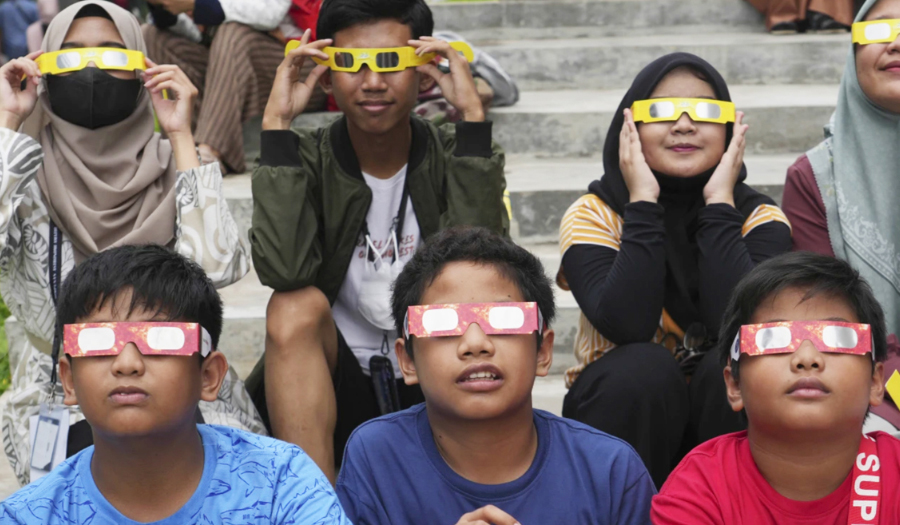By MARCIA DUNN
Tens of millions in the Americas will have front-row seats for Saturday’s rare “ring of fire” eclipse of the sun.
What’s called an annular solar eclipse — better known as a ring of fire — will briefly dim the skies over parts of the western U.S. and Central and South America.
As the moon lines up precisely between Earth and the sun, it will blot out all but the sun’s outer rim. A bright, blazing border will appear around the moon for as much as five minutes, wowing skygazers along a narrow path stretching from Oregon to Brazil.
The celestial showstopper will yield a partial eclipse across the rest of the Western Hemisphere.
It’s a prelude to the total solar eclipse that will sweep across Mexico, the eastern half of the U.S. and Canada, in six months. Unlike Saturday, when the moon is too far from Earth to completely cover the sun from our perspective, the moon will be at the perfect distance on April 8, 2024.
Here’s what you need to know about the ring of fire eclipse, where you can see it and how to protect your eyes:
WHAT’S THE PATH OF THE RING OF FIRE ECLIPSE?
The eclipse will carve out a swath about 130 miles (210 kilometers) wide, starting in the North Pacific and entering the U.S. over Oregon around 8 a.m. PDT Saturday. It will culminate in the ring of fire a little over an hour later. From Oregon, the eclipse will head downward across Nevada, Utah, New Mexico and Texas, encompassing slivers of Idaho, California, Arizona and Colorado, before exiting into the Gulf of Mexico at Corpus Christi. It will take less than an hour for the flaming halo to traverse the U.S.
From there, the ring of fire will cross Mexico’s Yucatan Peninsula, Belize, Honduras, Nicaragua, Costa Rica, Panama, Colombia and, finally, Brazil before its grand finale over the Atlantic.
The entire eclipse — from the moment the moon starts to obscure the sun until it’s back to normal — will last 2 1/2 to three hours at any given spot. The ring of fire portion lasts from three to five minutes, depending on location.
WHERE CAN THE ECLIPSE BE SEEN?
In the U.S. alone, more than 6.5 million people live along the so-called path of annularity, with another 68 million within 200 miles (322 kilometers), according to NASA’s Alex Lockwood, a planetary scientist. “So a few hours’ short drive and you can have over 70 million witness this incredible celestial alignment,” she said.
At the same time, a crescent-shaped partial eclipse will be visible in every U.S. state, although just barely in Hawaii, provided the skies are clear. Canada, Central America and most of South America, also will see a partial eclipse. The closer to the ring of fire path, the bigger the bite the moon will appear to take out of the sun.
Can’t see it? NASA and others will provide a livestream of the eclipse.
HOW TO PROTECT YOUR EYES DURING THE ECLIPSE
Be sure to use safe, certified solar eclipse glasses, Lockwood stressed. Sunglasses aren’t enough to prevent eye damage. Proper protection is needed throughout the eclipse, from the initial partial phase to the ring of fire to the final partial phase.
There are other options if you don’t have eclipse glasses. You can look indirectly with a pinhole projector that you can make yourself, including one made with a cereal box.
Cameras — including those on cellphones — binoculars, or telescopes need special solar filters mounted at the front end.
SEEING DOUBLE
One patch of Texas near San Antonio will be in the cross-hairs of Saturday’s eclipse and next April’s, with Kerrville near the center. It’s one of the locations hosting NASA’s livestream.
“Is the city of Kerrville excited? Absolutely!!!” Mayor Judy Eychner said in an email. “And having NASA here is just icing on the cake!!!”
With Saturday’s eclipse coinciding with art, music and river festivals, Eychner expects Kerrville’s population of 25,000 to double or even quadruple.
WHERE’S THE TOTAL ECLIPSE IN APRIL?
April’s total solar eclipse will crisscross the U.S. in the opposite direction. It will begin in the Pacific and head up through Mexico into Texas, then pass over Oklahoma, Arkansas, Missouri, Illinois, Indiana, Ohio, the northern fringes of Pennsylvania and New York, and New England, before cutting across Canada into the North Atlantic at New Brunswick and Newfoundland. Almost all these places missed out during the United States’ coast-to-coast total solar eclipse in 2017.
It will be 2039 before another ring of fire is visible in the U.S., and Alaska will be the only state then in the path of totality. And it will be 2046 before another ring of fire crosses into the U.S. Lower 48. That doesn’t mean they won’t be happening elsewhere: The southernmost tip of South America will get one next October, and Antarctica in 2026.










